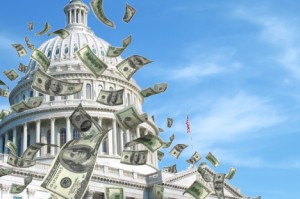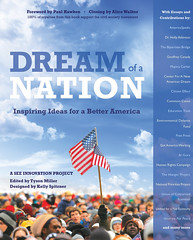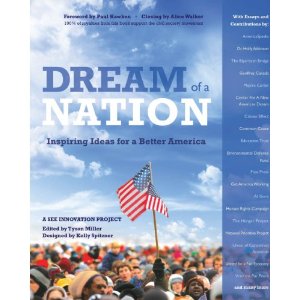Posted under
News on February 8th, 2012.
Comments Off on Eco Etiquette: Is ‘Made In America’ Better For The Environment?A wonderful article by Jennifer Grayson about American manufacturing. She refers to Dream of a Nation as "a new book that should be on every environmentalist's -- heck, every American's reading list." Aw shucks!
Eco Etiquette: Is 'Made In America' Better For The Environment? By Jennifer Grayson, HuffPost's Miss Eco Etiquette. Editor, The Red, White and Green. (Published on the Huffington Post)
I was shopping with my friend the other day, and she said she tries to buy American-made products whenever possible. From a green perspective, is this a good thing? I mean, what if it's between organic sheets made in China and regular ones made in the US?
-Jennie
...We will not go back to an economy weakened by outsourcing, bad debt, and phony financial profits. Tonight, I want to speak about how we move forward and lay out a blueprint for an economy that's built to last, an economy built on American manufacturing, American energy, skills for American workers, and a renewal of American values.
This blueprint begins with American manufacturing.
The President's State of the Union address Tuesday night, which included his declaration above, was a rousing call to action not only for American companies to reinvest in homegrown skilled workers, but for anyone who's ever felt a pang of guilt at the "made in China" tag on the back of a recently purchased T-shirt.
With some 5.6 million Americans still unemployed, creating incentives for US companies to move jobs back home will undoubtedly support the economy. So will buying American products: As ABC News has touted in its popular Made in America series, spending just $64 more than usual on US-made goods would create 200,000 jobs.
But what about supporting the eco-nomy? Does buying American-made also help the environment, as your friend suggests?
As a general rule, I believe it does. When you choose products manufactured here at home, you avoid the extra fuel expense of shipping foreign-made goods halfway around the globe. Those fuel costs are significant, considering that nearly 60 percent of everything we buy now is imported.
Then, too, there's the issue of the poor environmental standards in overseas factories that have given us lead in children's toys and melamine in dog food. In 2005, the Chinese Ministry of Health estimated that 200 million Chinese workers were regularly exposed to toxic chemicals. That same year, 386,645 workers died as a result of occupational illnesses.
Those statistics are appalling; similar occurrences would be unimaginable in American factories, where we have laws (and ahem, government regulation) in place to protect our workers and our natural resources. So by buying American-made, you're ostensibly supporting a cleaner, safer environment.
I could also spend the rest of this article calculating the potentially minimized land and water use involved in the making and transporting of the conventional cotton sheets versus the shipping-related fuel costs of the Chinese-made organic cotton ones, not to mention the recyclability of their PVC packaging. But such minutiae is missing the point.
I say, buy the American sheets and move on, because we need to talk about the bigger opportunity here, which is: Where we can focus our American manufacturing and purchasing efforts to have the biggest impact on the environment and our economy.
The answer is: Our infrastructure.
President Obama didn't make this connection in his speech (infrastructure was mentioned later, in the context of jobs), but a new book that should be on every environmentalist's -- heck, every American's -- reading list does.
The book is a collection of essays called Dream of a Nation, and much like the President's speech, it calls on us to come together as Americans in our work toward a sustainable future. Edited by Tyson Miller, each essay posits an innovative -- but eminently doable -- solution to our country's most challenging problems.
One essay, aptly named "Make It in America" (by Campaign for America's Future's Eric Lotke), raises a crucial point: If we're going to rebuild our crumbling roads and bridges, it's not enough to do it with American workers -- we need to do it with American parts.
Sound obvious? It's not. Lotke explains that while nations like Canada and the EU (and yes, even China) actively source home-manufactured products for their public projects -- even writing it into their trade agreements -- the US does not.
This is preposterous. Why are we importing Chinese steel modules to build American bridges (as was the case in the recent reconstruction of the San Francisco-Oakland Bay Bridge), when we could make them in America and create even more much-needed jobs here at home?
Why not make those parts here, where we can oversee the environmental conditions under which they were created, and account for their quality?
If the American parts companies either don't yet exist or aren't up to speed to produce the materials we need for these projects, we'll just have to create them or invest in their retooling, generating more American jobs in the process.
Of course, the Great Green Hope of making anything in America would include -- as Obama highlighted in his address -- the realization of our own clean energy economy. Completing the circle, that would mean bridges assembled by American workers, using products built in American factories that are powered by American-harnessed wind or solar power.
For now, it's the dream of a nation. But as the President laid out for the American people, the blueprint is there. We just have to follow it.
Follow Jennifer Grayson on Twitter: www.twitter.com/jennigrayson
From the Huffington Post
 With the elections just around the corner, it’s hard not to see just how powerful a role that money plays in politics. Fortunately there are organizations and others working to tackle this important issue and a light at the end of the tunnel.
With the elections just around the corner, it’s hard not to see just how powerful a role that money plays in politics. Fortunately there are organizations and others working to tackle this important issue and a light at the end of the tunnel.


 Dream of a Nation moves us past party lines and into the realm of what is possible. This important work guides even the most disillusioned of us toward innovative measures that, if implemented, could benefit society in amazing ways and make citizen activists out of us all. Inspiring!
Dream of a Nation moves us past party lines and into the realm of what is possible. This important work guides even the most disillusioned of us toward innovative measures that, if implemented, could benefit society in amazing ways and make citizen activists out of us all. Inspiring! I once gave an interview to a journalist at Fortune magazine, and after he turned off the microphone he told me I was dreaming, that reality was different. I replied that of course I am dreaming, that someone has to dream in America because dreams of a livable future are not coming from politicians, bankers, and the media. It is our right to dream, and it is something we owe our children’s children; it is a gift to the future and the future is begging.
I once gave an interview to a journalist at Fortune magazine, and after he turned off the microphone he told me I was dreaming, that reality was different. I replied that of course I am dreaming, that someone has to dream in America because dreams of a livable future are not coming from politicians, bankers, and the media. It is our right to dream, and it is something we owe our children’s children; it is a gift to the future and the future is begging.